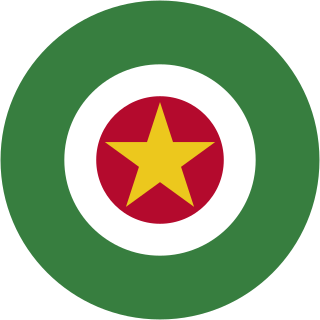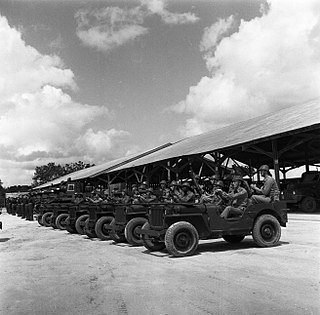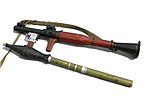
Suriname, officially the Republic of Suriname, is a country in northern South America. It is bordered by the Atlantic Ocean to the north, French Guiana to the east, Guyana to the west, and Brazil to the south. At under 165,000 square kilometers, it is the smallest country in South America.
After the creation of the Statute of the Kingdom of the Netherlands, the Royal Netherlands Army was entrusted with the defence of Suriname, while the defence of the Netherlands Antilles was the responsibility of the Royal Netherlands Navy. The army set up a separate Netherlands Armed Forces in Suriname. Upon independence in 1975, this force was turned into the Surinamese Armed Forces. On February 25, 1980, a group of 15 non-commissioned officers and one junior officer, under the leadership of sergeant major Dési Bouterse, staged a coup d'état and overthrew the Government. Subsequently, the SKM was rebranded as the National Army.
The Jungle Commando was a guerrilla commando group in Suriname. It was founded by Ronnie Brunswijk in 1986 to ensure equal rights for Suriname's minority Maroon population. The group was formed after the Suriname troops committed mass murder against 35 people in Moiwana Village, near Moengo, after the Suriname national army failed to capture Ronnie Brunswijk. The Commando fought against Dési Bouterse and the Surinamese army in the Suriname Guerrilla War.

The Surinamese Interior War was a civil war waged in the Sipaliwini District of Suriname between 1986 and 1992. It was fought by the Tucayana Amazonas led by Thomas Sabajo and the Jungle Commando led by Ronnie Brunswijk, whose members originated from the Maroon ethnic group, against the National Army led by then-army chief and de facto head of state Dési Bouterse.

The 1980 Surinamese coup d'état, usually referred to as the Sergeants' Coup, was a military coup in Suriname which occurred on 25 February 1980, when a group of 16 sergeants of the Surinamese Armed Forces (SKM) led by Dési Bouterse overthrew the government of Prime Minister Henck Arron with a violent coup d'état. This marked the beginning of the military dictatorship that dominated the country from 1980 until 1991. The dictatorship featured the presence of an evening curfew, the lack of freedom of press, a ban on political parties, a restriction on the freedom of assembly, a high level of government corruption and the summary executions of political opponents.
Rudi André Kamperveen was a Surinamese football player, sports administrator, politician and businessman.

Sportvereniging Nationaal Leger, known as SNL, is the Surinamese football club of the national military, which currently plays in the SVB Topklasse. They play their home games in Paramaribo at the Dr. Ir. Franklin Essed Stadion.

The Suriname Air Force is the air component of the Military of Suriname. All aircraft of the Suriname Air Force undertake border patrols, utility transport, and search and rescue missions from Zorg en Hoop Airport, the Air Force's main base. Aircraft are occasionally transferred to other air bases in the nation, which include Johan Adolf Pengel International Airport, Major Fernandes Airfield, Albina Airstrip, and Moengo Airstrip. The head of the Suriname Air Force is the Commander of the Air Force, currently Lieutenant Colonel Marven van Huisduinen, who took over the role in March 2019 from former Commander Robert Kartodikromo. The Air Force is further split into several wings, including the Helicopter Wing, the current Commander of which being Captain John-Marc Arron.
Paul Bhagwandas was a Suriname battalion commander. He was one of the sergeants who participated in a military coup in Suriname on 25 February 1980. Bhagwandas was the third man in the military dictatorship after Dési Bouterse and Roy Horb and was known as "the executioner of Fort Zeelandia".
Roy Dennis Horb was a Surinamese military officer. He was one of the sergeants who committed a military coup in Suriname on 25 February 1980, and the right hand man of army leader Dési Bouterse.

Yngwe Elstak (1927–2010) was a Surinamese military officer. He was the first commander of the Surinamese Armed Forces, from November 25, 1975, until February 25, 1980.

Surendre Sradhanand "Soerinder" Rambocus was a Surinamese serviceman. For a short period, he was the highest-ranking officer of the Suriname National Army. He was involved in the unsuccessful coup d'état of March 1982 against the then dictator of Suriname, Dési Bouterse, and was executed on 8 December 1982 as one of the December murders.

The Suriname national badminton team represents Suriname in international badminton team competitions. The national team is organised by Surinaamse Badminton Bond, the governing body for badminton in Suriname. The first Surinamese national squad was formed in 1970 when a badminton team from Trinidad & Tobago visited Suriname.
The Surinamese National Badminton Club Championships, locally called in Dutch "Nationale Clubkampioenschappen" is the badminton league organized by the Surinaamse Badminton Bond (SBB) the governing body for the sport of badminton in Suriname, to crown the best badminton clubteams in Suriname. There used to be different levels for teams, premier A-Class called "Hoofdklasse", First division called "1e Klasse" and a Second division called "2e Klasse". For juniors there first used to be only an under-19 (U-19) age class, later changed in an under-21 (U-21) age class and under-17 (U-17) age class. From 2001 an under-15 (U-15) age class was added, but this changed in 2005 to an under-13 (U-13) age class.
Henry Roëll Neijhorst is a Surinamese economist who served as Prime Minister of Suriname from 31 March to 9 December 1982. He also served as Minister of Finance from 15 March to 15 August 1980.

The Commander of the Armed Forces is the professional head of the National Army, the military of the Republic of Suriname. The position dates back to the country's independence from the Netherlands in 1975, with the military being named the Surinamese Armed Forces until after the Sergeants' Coup in 1980.

The Netherlands Armed Forces in Suriname was the military force maintained by the Kingdom of the Netherlands in its colony of Suriname, in the area that is now independent Republic of Suriname.
Louis Alfred Gerardus Doedel was a Surinamese trade unionist. On 29 May 1937, he was involuntarily committed at the Wolfenbüttel psychiatric hospital by Governor Johannes Kielstra. Doedel was forgotten by the public and often presumed dead. He was not released until late 1979, and died shortly after release.

The Memre Boekoe barracks is a military installation in Paramaribo, Suriname. It was constructed during World War II as barracks for the American soldiers stationed in Suriname. It was originally named Kampement Gemenelandsweg. In 1950, it was renamed Prins Bernhard kampement. After the independence of Suriname on 25 November 1975, it was renamed Memre Boekoe barracks after Fort Boekoe, a fort used during the Boni Wars. It is currently used as the headquarters of the Surinamese Land Forces.























